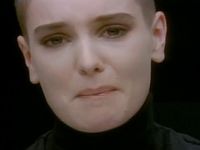The Shoot
| Close-up shot of Sinéad O'Connor |
 |
| Close-up shot of the main male performer of my music video |
The music video for Nothing Compares 2U focuses heavily on the artist, strongly marketing her without treating her in a voyeuristic way. This helped to improve our music video as in our first few shooting sessions, we recorded far too many medium shots. This music video is an example of why close up shots of the artist(s) and/or any other important people are essential - unlike medium shots, close up shots help you to engage with and relate to the person in question. As the artist is usually the major selling point of the music video, close up shots of them are very important. The images shown above are examples of close-up shots being used like this in the music videos for Nothing Compares 2U and Tonight I Let You Go (my music video).
In addition to my other research on montage, the montage used in the music video for Nothing Compares 2U is highly effective and the cross fades that are used so well in that montage are also used for the montage in my edit (read The Edit, below).
 |
| Cultural signifiers - such as statues - are used in the music video for Nothing Compares 2U |
 |
| The postbox, texting teenager, roads, cars, traffic lights, and housing estate are all signifiers of contemporary Britain |
The Edit
 |
| A cross-fade effect used in the montage in the music video for Nothing Compares 2U |
 |
| An example of the cross-fade effect that I utilized in the urban montage near the end of my music video |
As aforementioned, the montage in the music video for Nothing Compares 2U influences our music video. In my edit, there is a montage of shots that show the main character, the boy, walking through the city to the girl's house. The focus on subtle yet striking transitions - heavily relying on cross fades - in the music video for Nothing Compares 2U is reflected in my edit of our music video, as I also use many cross fades to make my edit of our music video more interesting and absorbing.
Furthermore, the music video for Nothing Compares 2U matches the action and the lyrics seamlessly to emphasize both and make you feel the emotions that Sinéad O'Connor's character is feeling. I have tried to do this myself, with lyrics such as " I keep on running" being matched with action that contains the main character running (whether it is physically or mentally). In my edit of our music video, I have also matched the sequence containing lyric cards to the part of the track that is (at least partly) written on the lyric cards. This is obvious, but needs to be done well to maximise the effectiveness of the lyric cards.




































